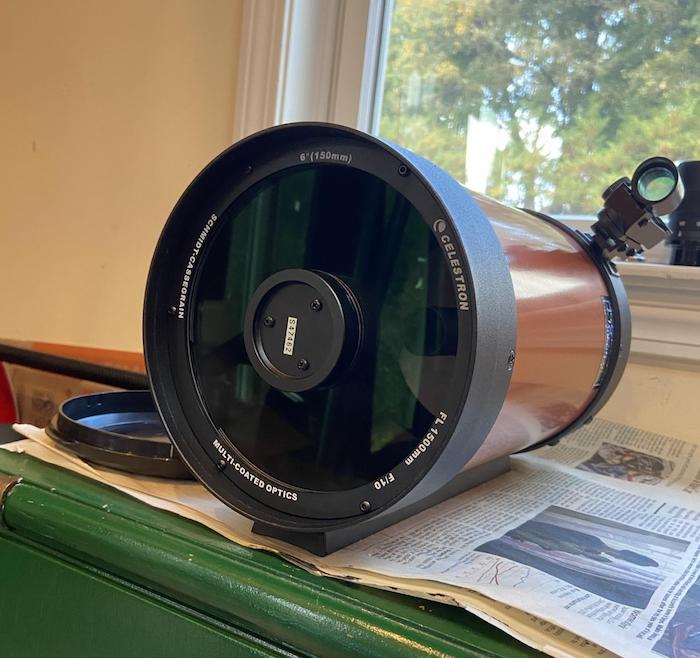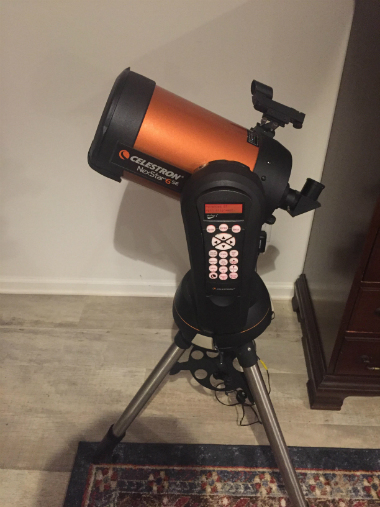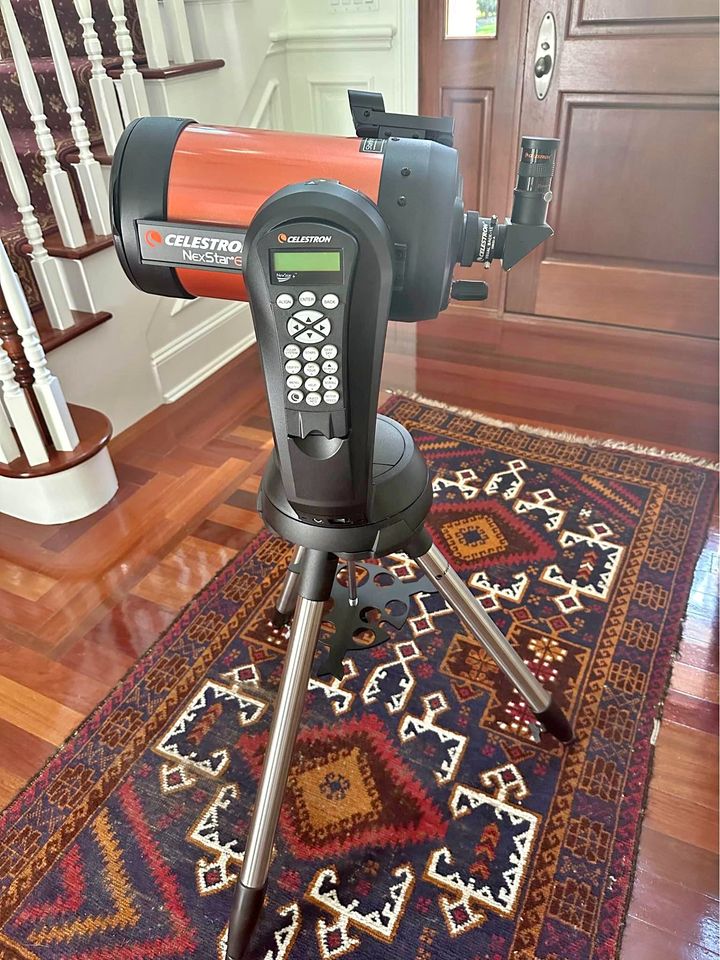The 6SE’s Optical Tube, C6
The 6SE’s optical tube is an orange version of the Celestron C6, which is a 6” f/10 Schmidt-Cassegrain. The C6 is the newest of Celestron’s standard SCT models, having been released as recently as 2006 (the other Celestron SCT models were devised in 1970, 1977, and 1993 for the C5/C8/C14, C11, and C9.25, respectively). The C6 offers significantly more light gathering ability and resolution than the C5, and is a favourite among experienced astronomers as a “grab n’ go” telescope.

Thanks to its small size, the C6 doesn’t really suffer from the mirror flop problems that plague larger Schmidt-Cassegrains nor have a particularly narrow field of view. That being said, despite being physically compatible with a 2” diagonal, the C6 cannot actually illuminate the field of view of a 2” low-power eyepiece and will vignette quite badly with an f/6.3 reducer. Thus, the scope isn’t going to provide a field of view much larger than 1 degree (about 2 full moons)-which means it isn’t ideal for wide-field vistas of star clusters and nebulae, though a 1-degree field is still plenty big to satisfy most users.
The C6 also has HyperStar compatibility. This means that with Starizona’s Hyperstar corrector, you can remove the secondary mirror, stick the Hyperstar in its place at the front of the telescope, and image with a CCD or CMOS camera at a focal ratio of f/2. However, the C6 only works with relatively small sensors in its Hyperstar configuration, both due to the physical constraints of the design and the fact that a large camera housing can start to obstruct most of the telescope’s aperture. Additionally, a HyperStar costs more than the entire telescope and is more useful if the C6 is mounted on a German equatorial mount rather than an alt-azimuth like the NexStar SE.

Being a Schmidt-Cassegrain, the C6 does need to be collimated from time to time. Contrary to what some folks might tell you, this is not a particularly scary or difficult process and absolutely does not require sending it back to Celestron! You simply adjust 3 small screws on the secondary mirror housing while pointed at a bright star – it’s arguably easier than collimating a Newtonian. Check out our collimation guide for more information. However, don’t buy the oft-advertised “Bob’s Knobs” or thumbscrew collimation knobs for the 6SE-they’re overpriced and counterintuitively cause the telescope to go out of collimation more often due to the insufficient torque they exert to keep the secondary secured tightly.
The Eyepiece and Red Dot Finger with 6SE
The 6SE comes with a single eyepiece – a 25mm E-Lux Plossl providing 60x. It’s a good starter eyepiece for low magnification, but as with any telescope, you’ll want at least a few extra eyepieces to provide a range of magnification options.
Like most GoTo telescopes, the 6SE also comes with a simple red dot sight to complete the initial alignment before it can automatically slew itself around the sky.
Nexstar 6SE Mount Capabilities
The 6SE and 8SE both use a larger version of the NexStar SE mount with a tall, single-arm fork and a rather robust steel tripod with 1.75” legs. Unlike the smaller mounts sold with the 4SE and 5SE, the 6/8SE mount does not come with a built-in wedge. The loss of this feature is not especially relevant, as it is little more than a useless gimmick on those telescopes.

The NexStar SE mount uses the same NexStar+ hand controller supplied with most of Celestron’s computerised telescopes. It looks pretty much like a pocket calculator. To use it, you enter your location, time, and date, point the telescope at two or three reference stars, and off you go. The whole process takes about 10 minutes from start to finish. Once the telescope is aligned, you can choose from lists of deep-sky objects, the planets, and double stars to point it at, which it’ll slew to automatically with high accuracy, assuming you’ve aligned it properly. However, getting the initial alignment to work can be challenging for some beginners, and the NexStar controller makes no indication of where in the sky your targets are or what is visible. Additionally, most of the objects available in its catalogues are too faint for the C6 to reveal, and its “40,000 objects” claim is mostly due to the fact that it features tens of thousands of SAO-designated stars. You’re basically limited to the solar system, the Messier catalogue, and many of the brighter NGC objects.
Should I buy a Used NexStar 6SE?
If the price is right, go for it. Make sure that the telescope powers on and slews correctly, and that the interior of the telescope is clean.
Alternative Recommendation
Under £800
- The StellaLyra 10”/Zhumell Z10/Orion SkyLine 10 offers 2.8 times as much light collecting power and just under double the resolution of the NexStar 6SE, mounted atop a simple and easy-to-aim Dobsonian mount that sets up in seconds and with a variety of high-quality features and accessories like a built-in 2” dual-speed Crayford focuser and cooling fan along with a 9×50 right-angle finder, laser collimator, and 2” wide-angle eyepiece. It’s got nearly unprecedented value for the money and the views will knock your socks off.
- The StellaLyra 8”/Zhumell Z8/Orion SkyLine 8 is a similarly great bargain to the larger AD10/Z10, though if you can afford the larger of the two models you’ll be rewarded greatly as the overall weight and bulk difference between a 10” and 8” is nearly immaterial.
- The Sky-Watcher Virtuoso GTi 150P features full motorized tracking and GoTo like the 6SE, and its tabletop Dobsonian mount and collapsible optical tube take up about as much space as the 6SE optical tube and mount head – thus opening up the possibility of a carry case or backpack and airline travel. You do need a steady surface to set it on, but if you can accommodate that need you’ll be rewarded with a wider field of view than the 6SE can achieve with the ability to aim the telescope entirely manually as well as control its mount via your smartphone/tablet instead of an old-fashioned hand set controller. The Virtuoso GTi 150P is also available in an all-manual configuration as the Heritage 150P from Sky-Watcher.
- The Celestron Astro Fi 130 has less aperture than the 6SE, but its vastly shorter focal length and the ability to take 2” eyepieces allows you to achieve a much wider field of view which is more ideal for viewing deep-sky objects. The Astro Fi mount is also controlled via your smartphone or tablet rather than a hand controller. The optics are the same as those in the Heritage 130P tabletop Dobsonian.
£800-£1200
- The StellaLyra 12”/Zhumell Z12/Orion SkyLine 12 has double the aperture – thus double the resolution and quadruple the light gathering ability – of the NexStar 6SE, though its massive Dobsonian base and gigantic optical tube stand in stark contrast to the petite and ultra-portable design of the NexStar 6SE and its mount/tripod. This telescope is a monster for sure, but more than worth it – and arguably easier to use – if you have the space for it.
- The Celestron StarSense Explorer 10” Dobsonian offers the performance of any good 10” Dobsonian with the added bonus of Celestron’s StarSense Explorer technology to aim the telescope (though not for you – it just gives a readout and instructions on the display of your smartphone) and with handles on the optical tube and cutouts in its base to make transport a little less difficult. Like the 6SE, only a single 25mm Plossl eyepiece and red dot finder are provided, and the 2” Crayford focuser is only a single-speed unit. The 8” StarSense Explorer Dobsonian is also a good choice, though a 10” is equally portable and provides better views and thus we’d recommend the larger scope provided you can afford purchasing it.
- The Explore Scientific 10” Truss Tube Dobsonian has all the great performance of any 10” Dobsonian, vastly besting the NexStar 6SE yet collapsing into only a slightly larger volume when dismantled. This telescope is extremely compact compared to a solid-tubed 8” or 10” yet still comes together in minutes, and features an all-aluminum frame with no cheap plastic or particle board parts. The focuser is also a fancy 2” dual-speed Crayford design. However, the included finder and eyepiece are abysmal and you’ll need to buy or make a shroud for the open tube.
Aftermarket Accessory Recommendations
The NexStar 6SE is provided with almost no accessories besides a single low-power eyepiece and all the required basic fittings to use it. As such, it’s vital to acquire a few extra accessories and at least a couple of additional eyepieces to fully utilise this telescope’s capabilities and get the most enjoyable experience possible. A dew shield is a must-have for the 6SE, as it helps to decrease glare from nearby light sources making their way into the telescope, while also delaying frost or dew development on the 6SE’s front corrector plate and preventing pollen, dirt, and dust from accumulating, any of which can damage the fragile corrector and its coatings over time as well as ruining your view.
A 1.25” 32mm Plossl eyepiece for 47x with the NexStar 6SE offers a marginally wider field of view and lower magnification than the provided 25mm Plossl, which is more suitable for viewing deep-sky objects. A 2” star diagonal will vignette with the 6SE, as will an f/6.3 reducer and low-power eyepieces, so there’s little point in obtaining either. For medium-high power, we recommend a 1.25”, 16mm UWA (94x) or 15mm redline/goldline (100x). For higher magnification, a 10mm UWA (150x) or 9mm redline (167x) eyepiece is ideal, while a 7mm focal length eyepiece such as a UWA or planetary (214x) provides magnification near the limit of what you can expect to typically find useful with the 6SE on the Moon, planets, and double stars.
A UHC nebula filter can be fitted onto any of your eyepieces and augments views of nebulae with the 6SE, especially if you primarily observe from under light-polluted skies. While the scope’s constrained field of view is not optimal for colossal objects like the Veil Nebula, the filter contributes to observing smaller objects such as the Orion or Crab Nebula by intensifying their contrast and dimming the surrounding sky background.
You’ll almost certainly want a power supply like the Celestron PowerTank Lithiumor a TalentCell power bank to use with the 6SE rather than costly disposable batteries or fiddly extension cords. If desired, the 6SE can also be controlled over WiFi with the Celestron SkyPortal app or SkySafari Pro using the aftermarket Celestron SkyPortal WiFi adapter, emulating the Astro Fi and NexStar Evolution telescopes. Apart from the need for external power, a WiFi-equipped 6SE will work more or less identically to the Evolution at a much lower price, as the 6SE’s mount is already plenty stable and well-designed for the task of holding the C6 XLT optical tube.
What can you see with the Celestron NexStar 6SE?
Within the solar system, the Celestron Nexstar 6SE can do a lot. Expect to see the following:
- Mercury & Venus: Phases
- The Moon has a ridiculous amount of detail, with features as small as a mile visible. We could go and write paragraphs about how great the views of the Moon are with the 6SE, or arguably any decent telescope, but we couldn’t possibly do it justice, so we’ll let the views speak for themselves.
- Mars: The ice caps are fairly obvious even when Mars is far from Earth. Around opposition, you can see a bunch of dark shaded areas, which are just duller colored sand.
- Jupiter: The cloud bands and Great Red Spot look great. With good sight, you can pick out mottled details and ripples within the cloud bands and the brownish polar zones. Jupiter’s 4 large moons are especially obvious as disks when they eclipse and transit the planet.
- Saturn’s rings are easily visible, as is the Cassini Division within them, the latter provided you have good sight. Around half a dozen moons can be spotted, along with faint variations in the tones of Saturn’s cloud bands. Saturn’s largest moon, Titan, is visibly not a star and appears a slightly gold colour.
- Uranus – A small turquoise dot. The moons are out of reach of anything under 10 inches in aperture.
- Neptune – A near-stellar blue dot. Its largest moon, Triton, can just barely be glimpsed under dark and steady skies.
Outside the Solar System, the NexStar 6SE is a solid performer, albeit limited somewhat by its aperture and field of view. You can expect to see a lot of open star clusters like M35, M11, and M67. Some large clusters, like the Pleiades (M45) and Beehive (M44), cannot fit into the field of view with the 6SE, though they can still be enjoyed. The bright globular star clusters such as M13, M15, and M22 are kind of resolved with 6 inches of aperture-though barely, and only with fairly decent skies. Smaller globulars will remain fuzzy patches of light.
The few bright emission nebulae that dot our skies look magnificent in the 6SE, particularly if you use a good UHC nebula filter on them. The Trapezium star cluster’s fainter members, nestled within the heart of the Orion Nebula, are an easy catch. Planetary nebulae look decent with the 6SE, and some begin to show teal or blue coloration.
The 6SE’s aperture is enough to start showing you a fair number of galaxies, but you won’t see detail unless you are under truly dark skies. With dark skies, however, galaxies start to come alive – M51’s spiral arms can be vaguely glimpsed, as can the dust lanes in M82, M64, and M31. M33, M63, and M101 may also reveal faint spiral arms.
The Celestron NexStar 6SE is also a fantastic double star splitting scope, especially thanks to its lack of diffraction spikes from spider vanes that a Newtonian reflector typically suffers from. Sub-arcsecond doubles are possible with good seeing conditions.


